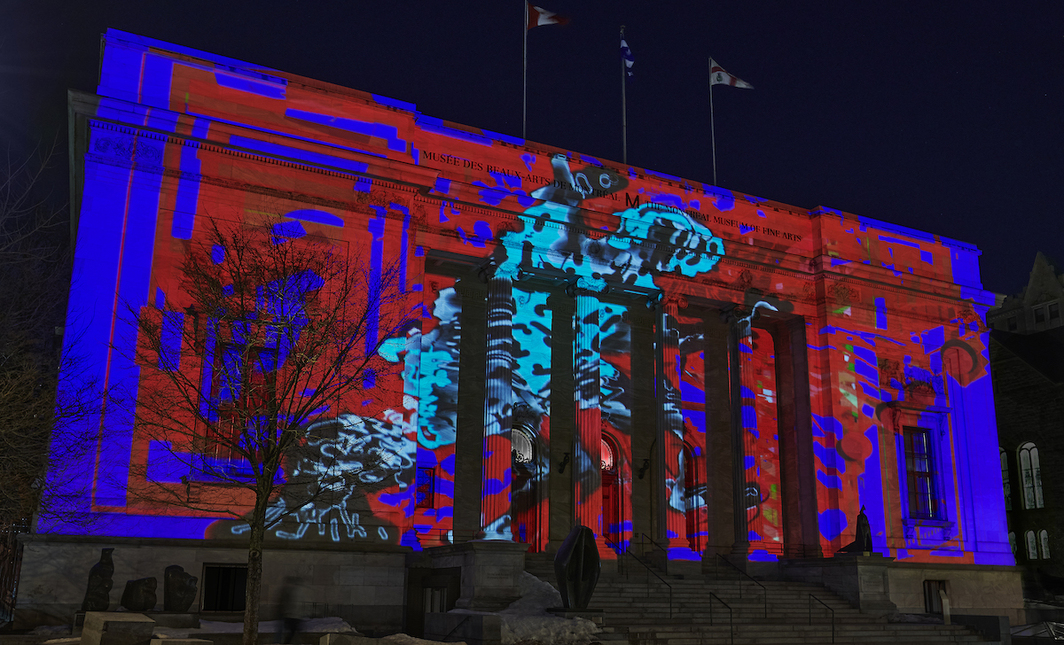
Nalini Malani, Ballad of a Woman, 2023, video projection, color, silent, 4 minutes 58 seconds (looped). Installation view, Montreal Museum of Fine Arts. Photo: Jean-François Brière.
Nalini Malani was recently awarded the prestigious Kyoto Prize and this year was the subject of two major museum exhibitions—the ongoing “Crossing Boundaries” at the Montreal Museum of Fine Arts and the just-closed “My Reality Is Different” at London’s National Gallery—in which new large-scale video projections extend the pioneering artist’s decades-long commitment to telling the stories of women’s oppression. Below, Malani talks about her beginnings as an artist and discusses social issues in India, the importance of memory, and the moving image in her expansive body of work.
IN INDIA DURING THE 1960s, to be a woman artist was unacceptable. I had to convince my parents that the profession I would take was drawing for medical textbooks. Leonardo’s drawings were used at medical schools. My first illustrations were of the insects and frogs that I dissected in class. My biology teacher taught me to draw and make the connections between human life and the cycles of nature. Ever since then, I’ve made hybrid characters that are a combination of plants and animals absorbed into the human body. I don’t want to forget the fact that we are animals. We tend too much to separate ourselves from nature, which is an existential part of us.
My family were refugees from Karachi, what later became Pakistan. In 1946, I was not even a year old when my mother brought me in the boat to Bombay. My father initially stayed in Karachi because my grandparents refused to move until riots started. After World War Two, India was too poor and became a liability for the British, so they decided to quit and draw the border called the Radcliffe Line, which was followed by communal massacres. During the Partition, more than 300,000 people died and a huge number of women were raped. This meant a lot of women lost their lives by the hands of their own family, because rape meant dishonor. Fifty years after Partition, in a collaboration with Pakistani artist Iftikhar Dadi, we made an artwork called Bloodlines. I have a lot of respect for sociologist Veena Das, who has written on the partition and the women who had no voice or lived with shame.

Nalini Malani, Can You Hear Me?, 2018–20, nine-channel video with 88 hand-drawn iPad animations, color, sound. Installation view, Montreal Museum of Fine Arts. Photo: Jean-François Brière.
My work is about how women are denied from having a sense of agency in a patriarchal society. Middle-class families in India still think first about getting girls married, starting a family, and “settling down.” Feminist philosophers such as Simone Weil and Adrienne Rich inspire me for how they broke through societal limitations on women to pursue their intellectual, political, and humanitarian goals. As a woman, you cannot run away from politics, and as an artist, you have to find strategies to make your point.
My work is not about my story, but about the hierarchal society in India. There is virtually no pathway to upward mobility. In the past, even if the shadow of a Dalit touched a person, that person considered himself to be “contaminated” and in need of a bath. But things haven’t changed much, and other types of discrimination continue to happen, such as the removal of existing higher education opportunities for the lower classes. Democracy has to be earned every time. It cannot be taken for granted. Artists reflect the world around them, and reflect the possibility of a better world.
People in India are drawn to time-based art. They’re used to seeing a lot of popular cinema that makes use of montage, which is a sophisticated way of looking at things. You put together different independent shots and you have a story. When I do something with moving images, immediately people come into the gallery to see and hear what is happening. Similarly, with my wall drawing/erasure performances, people look over my shoulder, and an interaction takes place. I like people to come and go. It has a kind of performative feeling, but not choreographed. At the end of the exhibition, I get someone to erase the drawing completely. At my retrospective at Centre Pompidou in 2017, I made a twenty-five-meter wall drawing called Traces and had the curatorial team erase it using dead red roses. In these works, there is nothing to buy or sell. You take away what you see.
— As told to Silvia Benedetti
ALL IMAGES
